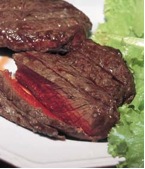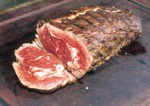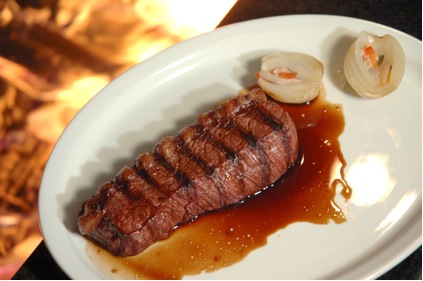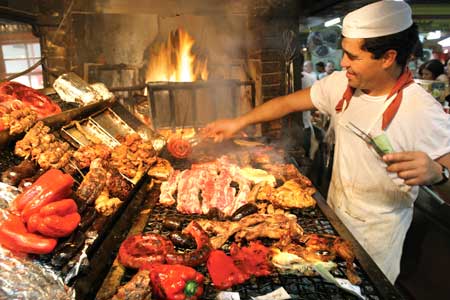by Marcelo Lima
Food photographs courtesy of Manual do Churrasco Magazine
Brazil is a huge country with many different heritages. Much like Americans, the Brazilian people are the sum of all the immigrants that moved in since these lands were discovered on April 22, 1500 (there’s a little controversy on this date, but it’s close enough). There seems to be a dominant presence of African, Italian, Portuguese, Spanish and Japanese descendants (did you know that São Paulo has the largest Japanese community outside of Japan?). Let’s not forget that a significant part of the Brazilian people have a cultural heritage that dates back to the ones that were here when the Europeans arrived—the Native American Indians.
That being said, each different group of immigrants adapted at least a little bit of their culinary habits to the making of a barbecue. For instance, the Brazilian gaucho way of experiencing a churrasco is strongly influenced by Italian and German cuisines. This is because the Brazilian southern states bordering Argentina and Uruguay (Rio Grande do Sul being the furthest one south), are where most of the Italian and German immigrants established themselves in Brazil.

Gauchos are the cowboys of Brazil.
Such influence translates itself into the herbs and spices that some recipes call for, and in the side dishes that complete a churrasco meal (for example, the italian polenta). However, it should be noted that when it comes to seasoning the meat itself, usually coarse salt alone will get the job done. The gaucho churrasco is also strongly influenced by neighboring countries Argentina and Uruguay. Gauchos are not just Brazilians. The gaucho concept is more related to a particular region of South America—the Rio da Prata Valley, part of which is called the pampas, which includes lands in Rio Grande do Sul (Brazil), Argentina and Uruguay. Saying that the gauchos are the cowboys of the pampas is an accurate description of what they do. It seems to me that the gaucho way of making a barbecue is more related to the culture of our southern neighbors. The Brazilian gauchos are a very peculiar and different community in comparison to everyone else in the rest of Brazil.
True gaucho barbecue is different from the ones I have where I live—Brasília-DF, the capital of Brazil. The traditional way of making a gaucho barbecue calls for a large skewer, most likely a huge piece of beef rib, and a hole in the ground where the fire is lit, and slow cooking. The thing is, the “true Brazilian deal” is actually a sum of several different truths on how to season, cook and eat the churrasco. The following recipes show techniques that are widely used by Brazilians, including the gauchos, when cooking meat. However, they should not be regarded as the only way we do it.
From left: The raw, seasoned rib eye ready for grilling; this is how the rib eye should look when you remove it from the grill.
Rib Eye
This is a very popular cut in Argentina also know as ojo del bife, bife ancho, and noix. The first thing you do is season it generously with coarse salt ONLY, on both sides. Let it rest for 15 minutes. Place the meat on a very hot grill, four inches over the coals, and leave it be for 10 minutes. Turn the piece just once. Be careful not to prick the meat. Let it be for another 10 minutes, then remove from the grill. Cut the meat into one-inch slices. Place the steaks back on the grill for five minutes on each side. This is enough to cook a medium steak.
Here´s the finished dish. Tuck in!
Baby Beef (Beef Tenderloin)
Cut the baby beef into 3-cm (a little more than 1-inch) steaks. Add a thin layer of vegetable oil to avoid dryness during cooking. Place the meat in a bowl and add powdered basil. Add coarse salt to both sides of the steaks. Place the steaks on a grill. Place in the barbecue 12 inches above the embers for 15 to 20 minutes, turning the meat once after 8 to 10 minutes. Carve and enjoy!
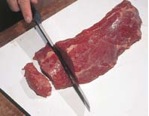
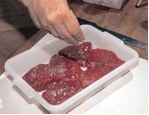

From left:slicing the beef into steaks; seasoning the steaks; the grilled beef.
Rump Steak (Picanha)
First, you´ll need a good quality, well-marbled piece of picanha of about two pounds. Using a very sharp knife, slice off the tip of the picanha. Slice off both sides of the picanha, leaving the center piece. Very carefully slide your knife across the middle of the center cut but do not separate the pieces. The center piece should be spread open and look like a long steak. If necessary, even out the excess fat (it should be just 1/2 inch wide).

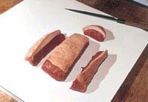
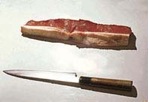
From left: cutting down the picanha; the center cut ready for slicing; the center cut ready for grilling.
Spread a thin layer of vegetable oil on the meat and add some coarsely-ground salt. Place the meat on a grill about 8 inches from the embers for 8 minutes per side (or until little puddles of blood appear on top of the meat). Here it is! Paradise on a platter! This is called bife de tira.

